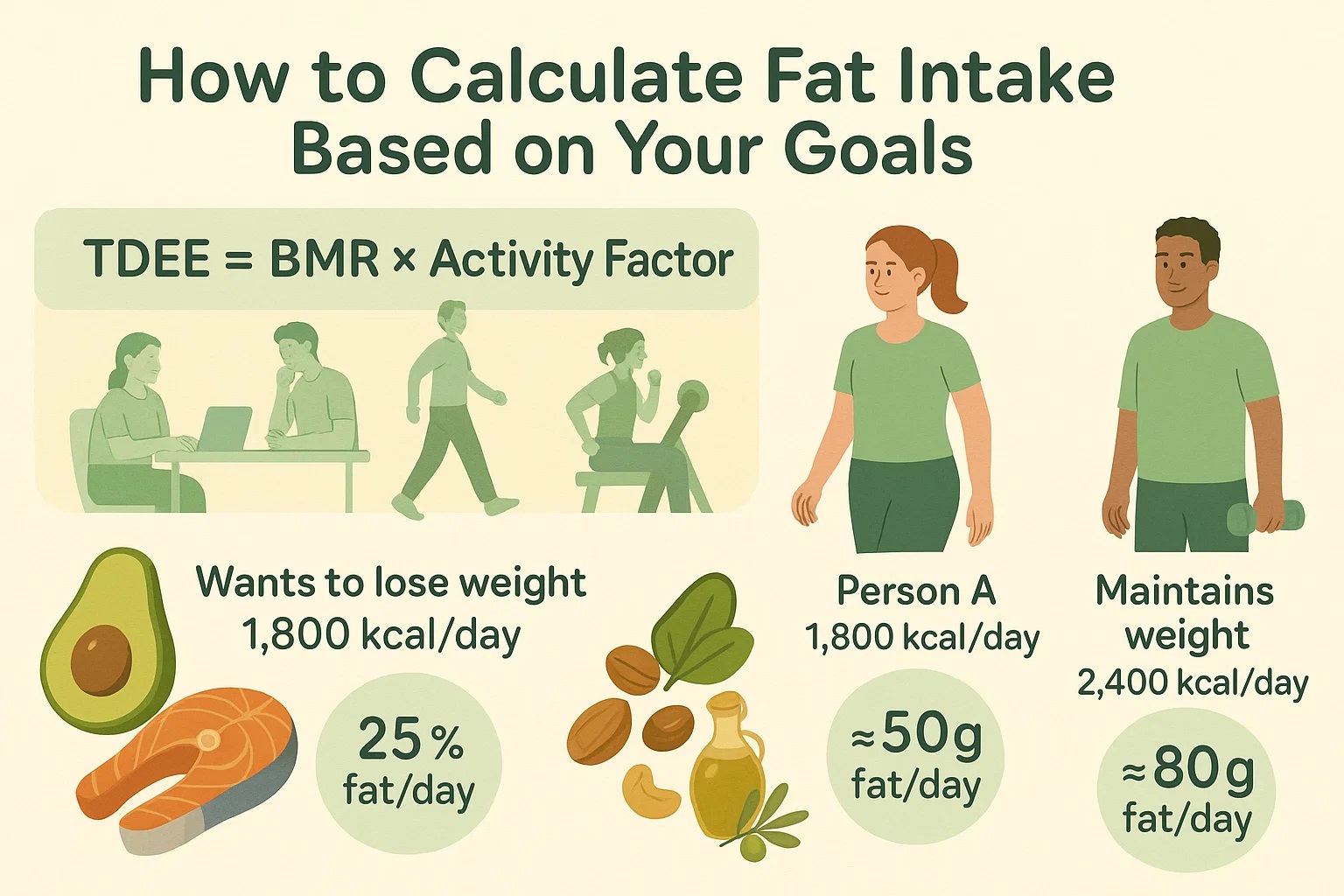Fat Intake Calculator

The fat intake calculator is a helpful tool for anyone looking to balance their diet, whether their goal is weight loss, performance, or simply better health. While fat is often misunderstood, it plays a crucial role in hormone production, brain function, and nutrient absorption. But knowing how much fat I should eat to lose weight or how many grams of fat per day to lose weight can feel confusing. That’s why this guide will help you break it down, based on guidelines from health authorities like the USDA and NIH, so you can make informed decisions about your nutrition.
Fat Intake: More Than Just a Number
In nutrition and health planning, fat intake isn’t just a background detail — it’s central to building a well-balanced, goal-driven diet. The fat intake calculator is more than a handy tool; it's based on solid scientific guidelines to help you figure out your ideal fat range, factoring in your Total Daily Energy Expenditure (TDEE), activity level, and wellness goals. While general advice works for some, personalized nutrition is more effective. Most health authorities, including the USDA and WHO, recommend that fat make up between 20% and 35% of your daily calories. A tailored approach supports not only weight management but also hormone health, brain performance, and absorption of fat-soluble nutrients. Understanding and adjusting your fat intake plays a bigger role in preventive health than ever before. That’s why using a calculator isn’t just helpful—it’s a smart step in aligning your habits with evidence, not guesswork.
What Is Dietary Fat?
Fat is one of the three main macronutrients your body needs to survive, alongside protein and carbs. It’s calorie-dense (9 calories per gram) and plays a vital role in cell structure, hormone production, and absorbing essential vitamins. There are different types of fat: saturated, unsaturated (including monounsaturated and polyunsaturated), and trans fats. Unsaturated fats — found in things like avocados, nuts, and oily fish — offer heart health benefits. On the other hand, high intake of saturated and trans fats (like those in processed foods) has been linked to heart disease risk. Understanding these differences is essential, especially when using tools like the fat intake calculator to plan meals and set targets. It’s not just about how much fat you eat, but the kind you’re putting on your plate
How to Calculate Fat Intake Based on Your Goals
The first step in determining your daily fat intake is figuring out your Total Daily Energy Expenditure (TDEE). This number reflects how many calories your body uses in a day, from basic functions to workouts and everything in between. Once you know your TDEE, you can calculate what percentage of those calories should come from fat — usually between 20% and 35%, depending on your goals and routine.
For example, someone consuming 1,800 calories a day and targeting 25% fat intake would aim for around 50 grams of fat daily. Meanwhile, a more active person eating 2,400 calories might choose a 30% target, which equals about 80 grams of fat. As you can see, the right fat intake isn’t universal — it’s personal.

Fat intake formula:
TDEE = BMR × operating coefficient
TDEE × Fat % = Daily fat calories
Daily fat calories ÷ 9 = Grams of fat per day
Fat Intake by Age, Gender & Life Stage
Fat needs vary depending on your age, gender, and health status. The WHO suggests that adults get 20% to 35% of their calories from fat, limiting saturated fat to under 10%. But this guidance shifts throughout life. Young children may need more fat — up to 45% of their calories — to support rapid brain growth. Pregnant and breastfeeding women are advised to increase their intake of healthy fats like omega-3s for fetal and infant brain development.
Gender matters, too. Research shows women naturally store more fat than men, especially subcutaneously, which can affect how they metabolize and utilize fat. And if you have conditions like type 2 diabetes or high cholesterol, your fat intake (especially saturated and trans fats) should be more carefully managed, ideally under medical guidance.
Misconceptions About Fat
Fat still suffers from outdated myths. One of the most persistent? “Eating fat makes you fat.” It’s not that simple. Fat, protein, and carbs are all processed differently in the body. In fact, long-term studies — like those from Harvard and the Nurses’ Health Study — show that low-fat diets don’t always lead to better weight or heart health outcomes.
Another myth is that all saturated fats are bad. Yes, excessive intake raises LDL cholesterol, but newer research highlights the importance of the fat source. Saturated fats from whole foods like dairy or coconut might not have the same health impact as those from processed meats. During the ‘fat-free’ craze of the 1990s, many people replaced fat with refined carbs and sugar, and ironically, this led to increased obesity and metabolic
When Fat Was the Hero
Fat hasn’t always been the enemy. In fact, for some cultures and groups, high-fat diets are a norm, and even beneficial. Take the Inuit population, whose traditional diet included over 70% of calories from fat, mainly from omega-3-rich marine animals. Despite this, they historically had low rates of heart disease, likely because of the type of fat and absence of refined carbs. From elite athletes to tech CEOs, high-fat diets (like keto) have long had a place in functional nutrition.

What Does Fat Intake Look Like in Meals?
It’s one thing to know you need 60 grams of fat a day, but what does that look like in real food? Here’s a practical snapshot:
-
2 tablespoons olive oil – 28g
-
1 small handful of almonds – 14g
-
½ avocado – 12g
-
A serving of grilled salmon – 6–8g
Together, these foods give you healthy unsaturated fats, plus protein, fiber, and essential nutrients. Compare that to a fast-food meal loaded with fries and mayo — it may hit your fat target, but with mostly saturated and trans fats, not the kind that supports your health.
Explore the Health section to find more smart tools that support your goals.
